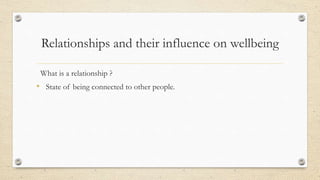
Relationship and their influence on well being
- 1. Relationships and their influence on wellbeing What is a relationship ? • State of being connected to other people.
- 2. Types of relationships • Family Relationship- Having biological bond, being born from the same family, individuals do not choose to be in this relationship • Friendship Relationship- We choose who we want to be connected with. This type of a relationship is the one at which individuals choose whom they prefer to be close to due to different reason • Casual Relationship- The relationship that can be formed when people come together or meet for a specific purpose, e.g. a teacher and a learner relationship is part of “causal relationship”. • Romantic Relationship- The kind of a relationship which can be formed under the influence of mutual feelings
- 3. Healthy and unhealthy relationships (good and bad)
- 4. Relationships that contribute or are detrimental to well being. All relationships that are healthy have the ability to contribute to our well-being. Healthy relationships contribute to our well being as we are appreciated and respect. Our best interests are important as we are encouraged to achieve our goals. Our relationship partners are also honest with us. Unhealthy relationships are detrimental to our well-being as we are always second guessing ourselves and our ability, If we are constantly put down by our relationship partners we start accepting what is being said about us as the truth. We live in constant fear of ridicule and judgment.
- 5. Social and cultural views that influence relationships And Rights and responsibilities in relationships Social and culture • Culture involves the beliefs, behaviors and values of a particular social group. Our cultural identity may include (but is not limited to) nationality, religion, gender, race, political affiliation, ethnicity and socioeconomic class. • Society influences our relationships as in has a role in how we view relationships and the roles played in relationships, for example girls are supposed to be submissive to their male counterparts in relationships. Rights and responsibilities • Each right carries with it a responsibility, actions we must take to show respect for other people. • Rights and responsibilities change for each relationship based on the nature of the relationship.
- 6. Relationships case study • Keke is a 17 year old girl, who lives with both her parents. Unfortunately both her mother and father are alcoholics who spend all of their wages sustaining their addiction. This leaves Keke and her siblings unattended and not provided for. Whenever Keke’s parents become drunk they become physically abusive and will usually blame their failures in life on her or her siblings. Though Keke tries to work hard in school, she is discouraged by her parents as they always tell her that she’s useless and will never achieve anything positive in life. Plus she sometimes can’t go to school as she still has bruises from her parents abuse. She wishes for a friend to speak to but she is isolated by her parents as they do not allow her to have any friends.
- 7. Questions based on the case study • What type of relationship does Keke’s scenario present us with? • Is it healthy or unhealthy? • Why do you say that? • How would you advise Keke? Homework Open page 14 Activity
